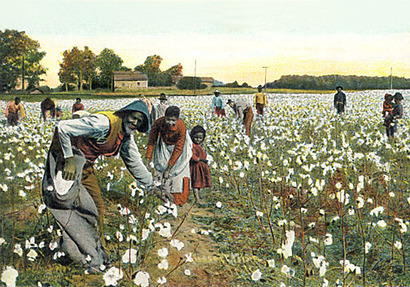Reformers in the Postbellum South: John C. Calhoun II and Alfred Holt Stone
IN THE CHAOTIC aftermath of the Civil War a struggle ensued within and outside the South between a faction of Radicals harboring animus toward the White race, and sensible men favoring a modus vivendi between the Whites of both sections. Many Radicals hated Whites, or at least Southern Whites, and wanted to see them subjugated by their former slaves.
Complicating matters further were huge numbers of newly-freed, uneducated, propertyless ex-slaves whose only capital was their labor, specifically, their skill as agricultural workers, and the presence of a ruthless, predatory mass of Southern Jewish merchants and financiers. It is not widely known that White Southerners (as a group) warmly embraced Jews, who they respected and admired. (Look at how Jews have repaid them.) Jewry seems to have established its foothold in the United States primarily in the South first, capturing the North only later.
There are many examples one could cite, but to name just three: Lehman Brothers (which failed in the Crash of 2008), Adolph Ochs (Chattangooa Times, then the New York Times), and Wall Street financier and “adviser to presidents” Bernard Baruch, the son of a Confederate physician and KKK member, all originally came from the South.
From a racial perspective, segregation of Blacks and Whites after the war (in the absence of deportation, which would have been the preferred solution) was vital. But for legal reasons segregation occurred in a messy and informal rather than measured and orderly fashion. The Dred Scott decision of 1857 had held that Blacks were not Federal citizens, and therefore had no U.S. citizenship rights. But a decade later the Civil Rights Act of 1866 (due to its dubious constitutionality it was reenacted in 1870) and the 14th Amendment (1868) suddenly granted U.S. citizenship to Blacks and severely restricted the sovereignty of White state governments. Consequently, separation of the races took place within a challenging legal framework.
While the legal and political aspects of segregation are fairly clear, the economic and educational dimensions remain comparatively opaque. Blacks were unquestionably second-class citizens (if that), laboring under severe economic and educational handicaps. At the same time, no matter what might have been done differently, the outcomes for Blacks and Whites could not have been equal. Denial does not alter this fact, nor does the substitution of today’s virulent anti-White racism for yesterday’s anti-Black racism.
When plantation owners could no longer operate large cotton- and tobacco-growing enterprises as they had formerly, four major options presented themselves: break large acreages into plots and sell them piecemeal to small farmers (“forty acres and a mule”; this, however, required capital, which most potential purchasers in the South did not have); rent individual plots to farmers (tenant farming); sharecropping; or the employment of farmhands on a wage basis.
But many former landowners had lost their holdings and were impoverished by the war. Those who survived lacked capital. And although our focus here is on Blacks, there were large numbers of White sharecroppers and tenant farmers as well. Well-known twentieth century depictions of their plight include The Grapes of Wrath (novel and film) and director Jean Renoir’s film The Southerner (1945). (Renoir was the son of renowned French painter Pierre-Auguste Renoir.)
Between 1865 and 1940 the Southern agrarian economy was characterized primarily by tenant farming and sharecropping. Of the two, tenant farming was preferable from the standpoint of the farmer. (See brief overview: “Sharecropping and tenant farming,” North Carolina Department of Cultural Resources, Office of Archives and History.)
The central role played by Jews in the economic exploitation and oppression of Blacks following the Civil War has not been blotted from the historical record so much as prevented from entering it in the first place. For detailed background on this subject, as well as the outsized Jewish role in slavery, I refer readers to three groundbreaking books published by the Nation of Islam that I have reviewed (“Jews and Slavery: Three Books by the Nation of Islam”). They are outstanding contributions to knowledge. It is astonishing that White critics of Jewish power did not discover and develop this mother lode of suppressed information before Blacks did. How many other vast topics in Jewish studies remain virgin territory? The Holocaust, slavery and Black oppression — what else?
The Secret Relationship Between Blacks and Jews, Volume 2: How Jews Gained Control of the Black American Economy (Nation of Islam, 2010) [browse it online here] provides valuable background about the myriad economic and legal techniques, frequently extremely subtle, complex, and dishonest, used by Jews to keep Black sharecroppers and tenant farmers in a state of economic servitude.
In “Concerning the Jews,” Mark Twain summarized the postwar situation of Southern Blacks as follows:
In the cotton States, after the war, the simple and ignorant negroes made the crops for the white planter on shares. The Jew came down in force, set up shop on the plantation, supplied all the negro’s wants on credit, and at the end of the season was proprietor of the negro’s share of the present crop and of part of his share of the next one. Before long, the whites detested the Jew, and it is doubtful if the negro loved him. (Harper’s New Monthly Magazine, September 1899, p. 530)
Years earlier Twain had touched upon this key feature of the Southern economy in his memoir Life on the Mississippi (1883):
Complaint is made that the planter remains grouty toward the former slave, since the war; will have nothing but a chill business relation with him, no sentiment permitted to intrude; will not keep a “store” himself, and supply the negro’s wants and thus protect the negro’s pocket and make him able and willing to stay on the place and an advantage to him to do it, but lets that privilege to some thrifty Israelite, who encourages the thoughtless negro and wife to buy all sorts of things which they could do without, — buy on credit, at big prices, month after month, credit based on the negro’s share of the growing crop; and at the end of the season, the negro’s share belongs to the Israelite, the negro is in debt besides, is discouraged, dissatisfied, restless, and both he and the planter are injured for he will take steamboat and migrate, and the planter must get a stranger in his place who does not know him, does not care for him, will fatten the Israelite a season, and follow his predecessor per steamboat.
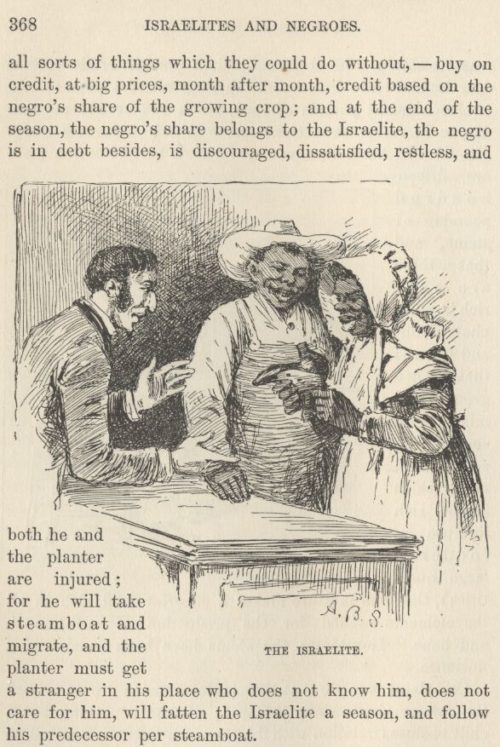
The Calhoun Land Company
It was this tendency of Blacks not to stay put and focus their energies for long that confounded the attempts some White businessmen made, on their own dime, to bypass Jewish exploitation and assist Black farmers in a fair and equitable manner. These reformers were not subsidized by government like today’s tens of thousands of patronage-backed, self-enriching “nonprofit” entrepreneurs, but were self-supporting men of commerce who needed to cover their costs and achieve a reasonable rate of return to remain in business. They hoped to circumvent the sharecropping system exploited by merchants and make tenant farming profitable for both themselves and their renters.
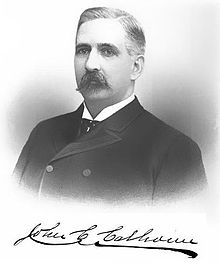
One such enterprise was the Calhoun Land Company, founded by two brothers, grandsons of prewar South Carolina statesman John C. Calhoun, U.S. Congressman, Senator, Secretary of War, Secretary of State, and Vice President of the United States. Calhoun was of Scotch Irish descent; he and his wife had ten children, three of whom died in infancy.
Colonel John C. Calhoun II, a businessman (his biography, including family lineage, can be read here), and his brother Patrick Calhoun, a prominent corporate lawyer in Atlanta, established the Calhoun Land Company to put their plan into action. John II’s wife was the grandniece of Richard Mentor Johnson, Vice President of the United States under Martin Van Buren. They had four children. Patrick and his wife had eight children; he died in Pasadena, California in 1943.
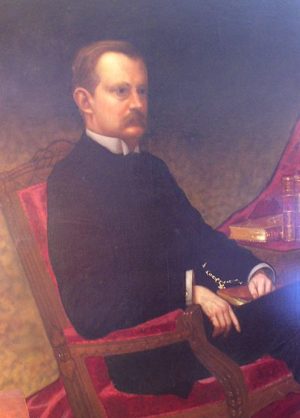
Including the original John C. Calhoun, these men had stable marriages and large families, far above the replacement rate. (John II and Patrick came from a family of six children themselves.) Replicated over and over across many families, such reproductive behavior had a salutary effect on White population size and structure over time, indicative of a healthy, dynamic, demographically expanding race. Nor was this pattern limited to the upper class.
I emphasize this in order to draw attention to what a race ultimately requires on a large scale in order to survive, because it has not characterized the White race for a long time. Needless to say, I am referring only to “like engendering like”: products of racial mixture do not count. They reduce and harm, rather than benefit and supplement, the White population.
The Calhoun Land Company was backed by Boston businessman J. Baxter Upham and New York City investor Austin Corbin, the proprietor of the Long Island Rail Road. Jews call Corbin “anti-Semitic” because he allegedly barred the pests from patronizing a resort he owned, Manhattan Beach in Brooklyn, New York.
The Calhouns purchased and consolidated nine Arkansas plantations. Mark Twain explained:
There was much talk on the boat about the Calhoun Land Company, an enterprise which is expected to work wholesome results. Colonel Calhoun, a grandson of the statesman, went to Boston and formed a syndicate which purchased a large tract of land on the river, in Chicot County, Arkansas, — some ten thousand acres —for cotton-growing. The purpose is to work on a cash basis: buy at first hands [sic], and handle their own product; supply their negro laborers with provisions and necessaries at a trifling profit, say 8 or 10 per cent; furnish them comfortable quarters, etc., and encourage them to save money and remain on the place. If this proves a financial success, as seems quite certain, they propose to establish a banking-house in Greenville, and lend money at an unburdensome rate of interest — 6 per cent is spoken of. (Life on the Mississippi)
After discussing, next, the exploitative role played by “the Israelite,” which I’ve already quoted, Twain concludes: “It is hoped that the Calhoun Company will show, by its humane and protective treatment of its laborers, that its method is the most profitable for both planter and negro and it is believed that a general adoption of that method will then follow.”
But that is not what happened. By 1885 the Calhouns had divested their Arkansas landholdings due to heavy debt. Part of the cause was the aftermath of the great Mississippi flood of 1882, also described by Twain in his book, though separately, and not in relationship to the Calhoun Land Company.
As against what I have just written, I should point out that the 1917 biographical sketch cited above states that the liquidation of the Land Company was in fact profitable, and that John C. Calhoun’s tenancy arrangements with Blacks were successful over a longer period of time. In addition, Calhoun was responsible for the westward emigration of literally thousands of Negroes (and thus their descendants) from the Carolinas, Georgia, and Alabama to the Mississippi Valley in furtherance of his planting operations.
Alfred Holt Stone and Dunleith Plantation
Another failed attempt at reforming Black tenant farming-sharecropping arrangements was made at the turn of the last century by Mississippi attorney, state legislator, tax commissioner, and planter Alfred Holt Stone. One source says his Dunleith Plantation made him “one of the largest individual cotton growers in the state.” He was racially aware, at least as far as Blacks are concerned, and amassed a library of over 3,000 items on The Negro and Cognate Subjects today housed at the University of Mississippi.

As plantation manager, Stone approached his problem in an open-minded, objective manner. He began his experiment in 1899 in an attempt to see whether it was possible to establish a stable Black workforce, an “assured tenantry” as he put it, that would not disrupt farm operations by continually migrating. The salient features of his program were
uniformity of the tenant system, all land being rented at a fixed cash rental; the sale of stock, implements, and wagons to tenants upon exceptionally favorable terms; the exercise of proper supervision over the crop; the use of a contract defining in detail the undertakings of each party; the handling and disposition of the gathered crop by the plantation management. (Alfred Holt Stone, “A Plantation Experiment,” Quarterly Journal of Economics, February 1905, 270-87)
The sale of implements and other chattels at favorable rates, and explicit written contracts clearly setting forth the terms of the agreement and the rights and duties of the parties, were great improvements, as the Nation of Islam’s study indirectly makes clear. Jewish merchants frequently overcharged for goods and employed oral contracts which they did not adhere to. Usually Blacks had no recourse against them.
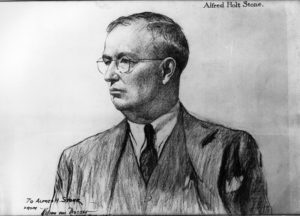
As with the Calhouns before him, Stone was very pleased with the results at first, except for the tendency of tenants to squander their profits without consideration for the future. He expected two-thirds of families to remain on the land. (That’s still a 33% turnover!) However, by 1904 just 8 of the 79 families (or 10%) that were with him in the beginning (1899) remained. The others had pulled up stakes and left, legally taking the livestock and implements obtained on Stone’s generous terms with them. This forced him to constantly find new tenants to replace those who had departed. Shrugging off his unusual fairness and all of the advantages that went with it, Black farmers left as soon as they had a mule and a little personal property paid for.
In 1904 Stone abandoned his progressive tenancy arrangements and reverted to a sharecropping system, writing, “We are no longer engaged in the altruistic practice of converting shiftless and empty-handed Negroes into desirable and well-equipped tenants for the benefit of other planters.”
This marked propensity of Negroes to suddenly pull up stakes and leave was described by Mark Twain in Life on the Mississippi.
We were getting down now into the migrating Negro region. These poor people could never travel when they were slaves; so they make up for the privation now. They stay on a plantation till the desire to travel seizes them; then they pack up, hail a steamboat, and clear out. Not for any particular place; no, nearly any place will answer; they only want to be moving. The amount of money on hand will answer the rest of the conundrum for them. If it will take them fifty miles, very well; let it be fifty. If not, a shorter flight will do.
Negroes, Stone believed, were an inherently “restless people” possessed of a “migratory instinct” joined with an “easygoing indolence, which seeks freedom to assert itself, and chafes under restraints which measurably restrict its enjoyment.”
Ever seeking change, they sometimes wander far afield, and traverse the boundaries of states in its pursuit. . . . They have been wanderers since emancipation gave free play to native instinct, and I do not see how love of home, in the real sense, could characterize a people who in the mass know so little of such an abode.
He considered it “ridiculous and unscientific to shut our eyes to the negro in Africa, untouched by American slavery, and charge to that institution whatever is bad or unpromising in the negro of the South.”
More than a century later, anti-White elites still plod the same well-worn path, blaming Black problems on a legacy of “discrimination” and fictional “white privilege” that Left-wing racists have fabricated out of whole cloth.
Alfred Stone believed mulattos stirred up unrest among his workers. He viewed them (that is, people like Obama) as a highly distinct group, somewhat analogous to Jewish anthropologist Stanley Garn’s much later classification of American Blacks (in his case all of them, which Stone did not do) as a new race due to their significant White genetic admixture. Stone wrote:
My position is that, in its mental and moral equipment, the Negro is inferior to the White [emphases added]; that most of the men who have come to the front as “race leaders,” and who are pointed to as the highest intellectual type of the race, are, in fact, not really Negroes — under any exact definition of the word; that these mulattoes, from their position of leadership, wield a large influence over the nine millions of our population classified as Negroes.”
Influence, he felt, that was more often than not baleful. Stone wrote an article on this subject for a general intellectual audience: “The Mulatto Factor in the Race Problem,” Atlantic Monthly (May 1903).
Although both Stone and the Calhouns cut their losses short after their idealistic experiments failed, Stone possessed an ability to acknowledge and reflect upon deep-seated Black-White racial differences, whereas John C. Calhoun II tended to view matters from a more conventional socioeconomic perspective. Consequently, Stone had a much better grasp of the difficulties confronting him. He knew when problems were not management-related. This is a lesson contemporary Whites need to learn as well, not just about Blacks, but about Jews and all other races, including their own.
* * *
Source: Author


